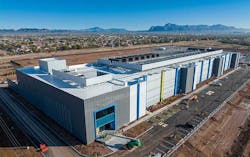Data Center Insights: Joe Goldsmith of NTT GDCA
The Data Center Frontier Executive Roundtable features insights from industry executives with lengthy experience in the data center industry. Here’s a look at the insights from Joe Goldsmith of NTT Global Data Centers Americas
Joe Goldsmith is Senior Vice President and Chief Revenue Officer at NTT Global Data Centers Americas (formerly RagingWire), responsible for all aspects of go-to-market strategy and execution including: sales, marketing, product management, business development, channels, and sales operations. Joe is a proven sales executive with more than 25 years of experience, including more than a decade in the data center industry.
Prior to joining RagingWire, Joe was the Chief Revenue Officer for Vantage Data Centers, utilizing his expertise in complex contract and lease negotiations to lead Vantage to become an industry leader in wholesale data centers. Previously, Joe was Vice President and General Manager at Digital Realty, where he led efforts related to global alliances, channel sales, and colocation products, growing the company’s annual revenues from $200 million to over $1.5 billion. He has also served as Executive Director of Global Accounts at Qwest, Director of Sales at FiberTower, and Vice President of Sales at Colo.com. He earned a Bachelor’s degree from the California State University-Sacramento.
Here’s the full text of Joe Goldsmith's insights from our Executive Roundtable:
Data Center Frontier: Recent earnings reports suggest the growth rate of cloud computing has moderated slightly. What’s your take on the progress of cloud computing – the “what inning are we in” question – and what lies ahead?
Joe Goldsmith, NTT GDCA: From our perspective, we’re not seeing a slowdown. Demand from our cloud-provider clients is as high as it’s ever been. It’s less chaotic than the past two years, but there is still a lot of demand for capacity from existing and new clients.
There may have been expectations of a slowdown three to six months ago, but new technologies have been announced in areas such as AI, and all the large cloud providers are launching AI solutions and investing significantly in them. Because of that, we're seeing a lot of demand in those areas.
We are at the start of a technology push. Higher-capacity processing and graphics processing units (GPUs) for applications that are around the corner are creating more demand. Most cloud providers have been able to keep up with their current demand, buying all the capacity available and preleasing future capacity, but they haven’t yet accounted for these new applications and solutions.
Data Center Frontier: How would you assess the state of the data center supply chain? What items continue to experience long lead times or availability problems?0
Joe Goldsmith, NTT GDCA: Challenges in the global data center supply chain over the past few years have led to substantial price increases and extended lead times. In response, the industry has started ordering equipment early and locking in production slots, which has further constrained the market and created extended supplier backlogs.
Some deliveries are now happening, whereas before there was a two-year delivery timeframe for most equipment. However, deliveries of everything electrical and mechanical remain a huge problem around the world.
It’s still taking about two years to deliver uninterruptible power supplies or generators. There are also long lead times for items like transformers for substations, and even chillers are pushing 12 to 16 months.
There have been some improvements in delivery of construction materials. We faced extended lead times for roofing, precast concrete and electrical components in 2022, but these now appear to have stabilized. The availability of construction labor has also improved in some geographies due to delays or pauses in other projects.
One hurdle that we have had to deal with is unpredictability in the delivery of equipment when there's an unanticipated need for certain components. Often, these needs only become clear closer to the equipment delivery date, which means our construction sites have had to become more proactive in equipment orders. We have therefore focused on working with our supply chain to mitigate these delivery delays.
Another global challenge is getting power to data centers from utility companies or other power providers. This is taking longer than expected because the ability of many of these utilities or providers to deliver power is tapped out. So, we’re forced to devise alternative ways of generating power for the data centers, which is causing an interesting shift in the data center industry here in the US, at least.
Data Center Frontier: Data centers have always been highly-automated facilities. What are the most promising opportunities in automation and data center management? Can AI, augmented reality, and robots play a meaningful role?
Joe Goldsmith, NTT GDCA: The data center industry has always relied on automation technology for efficiency and resilience. The resiliency and availability guarantees that our clients need are not achievable without automation.
Current data center automation tools and systems ensure that power supplies and cooling remain available even when power failures occur. And, providers need to constantly add more automation to keep up with the increasing demands on the data center from higher densities and increased cooling needs.
To keep data centers operating efficiently, building management systems and data center infrastructure management solutions use sensors and other feedback mechanisms to continually monitor and change settings.
These systems have usually relied on traditional fixed algorithms and manual monitoring to function. Examples include:
- Temperature feedback (too hot or too cold) to modify temperature settings
- Airflow sensors that can trigger filter replacements
- Measuring outdoor ambient temperatures, which can affect economization solutions
Now, AI-powered solutions promise to take automation to the next level without relying on isolated systems. They will be able to "learn" how underlying data center systems are related and make modifications that have not previously been considered. So, AI will help build better, more efficient and lower-cost data centers that meet sustainability goals.
Data Center Frontier: The industry has stepped up its efforts to attract and retain talent, but staffing remains a huge challenge. What’s working well, and what more can be done to build a diverse workforce of the future.
Joe Goldsmith, NTT GDCA: This is a tough one because it is always hard to find resources. For a while, all the hyperscalers were hiring a lot of people, and it was hard to retain people while they were getting poached. That’s changed amid the layoffs that several of the big tech companies have announced over the past year.
There now seems to be a little bit more of a talent pool out there – but it's still not enough. We’ve not solved the problem of attracting and retaining skilled staff, but we have tried to look outside of the typical places to create more diversity in our talent pool.
About the Author




